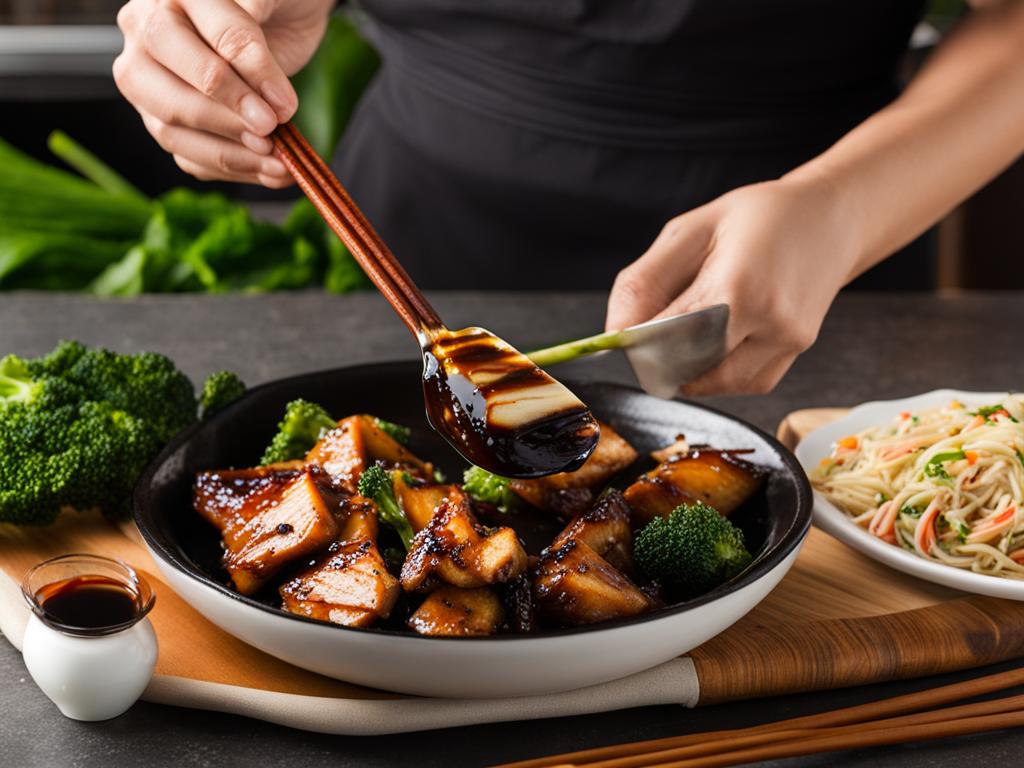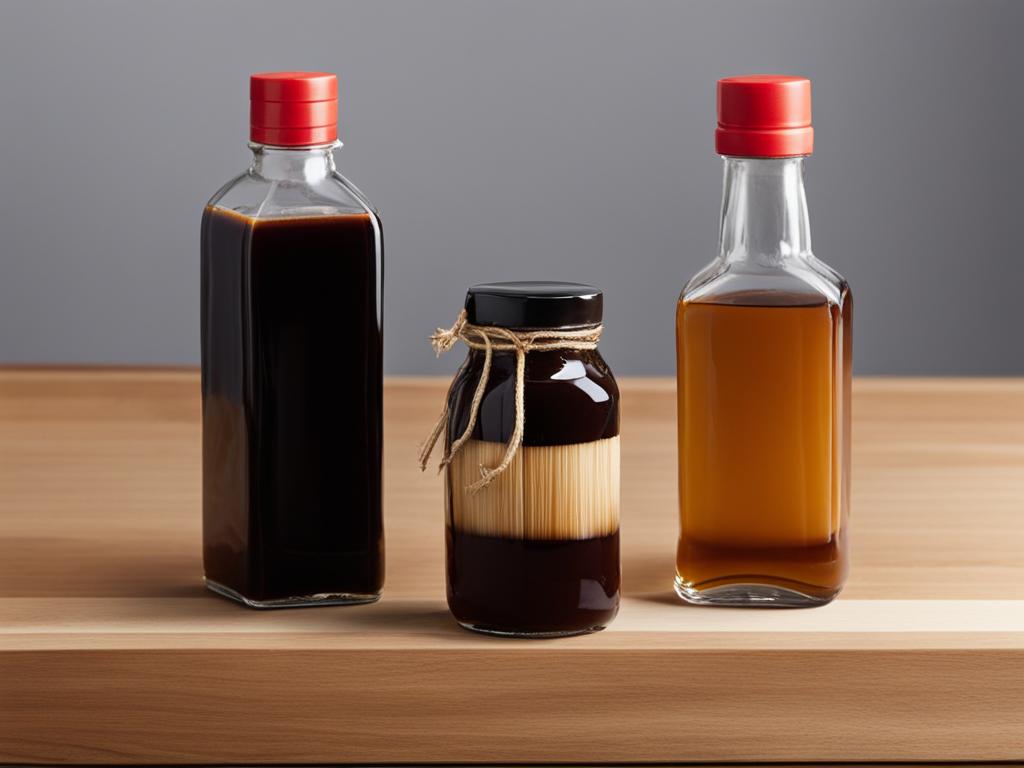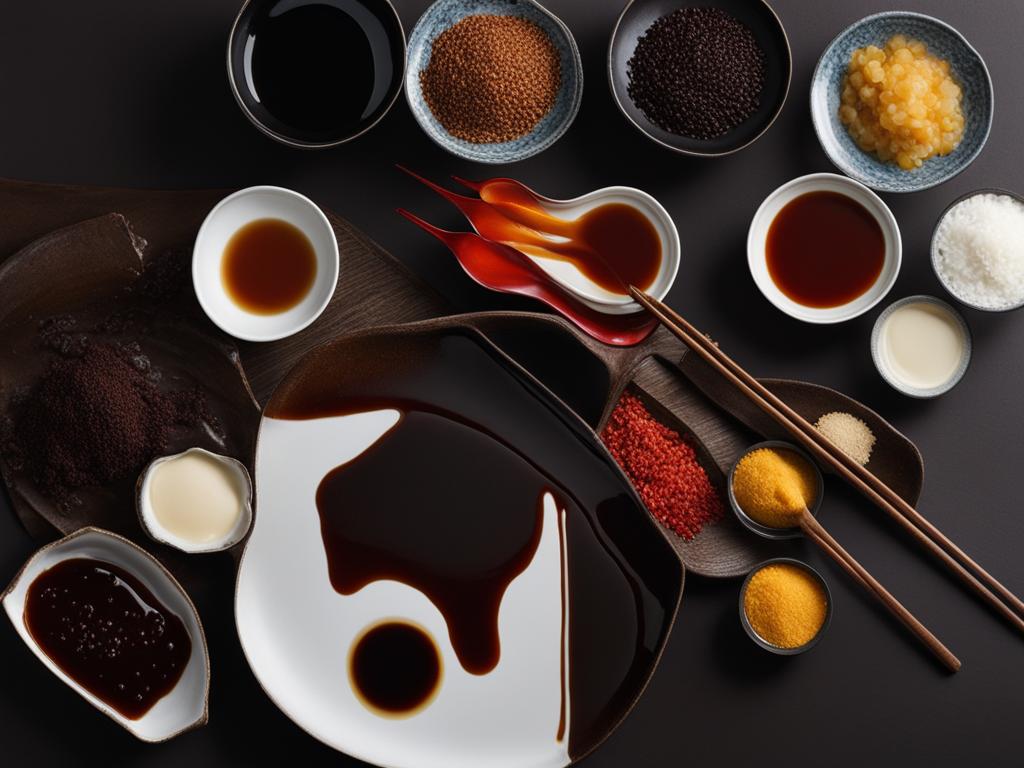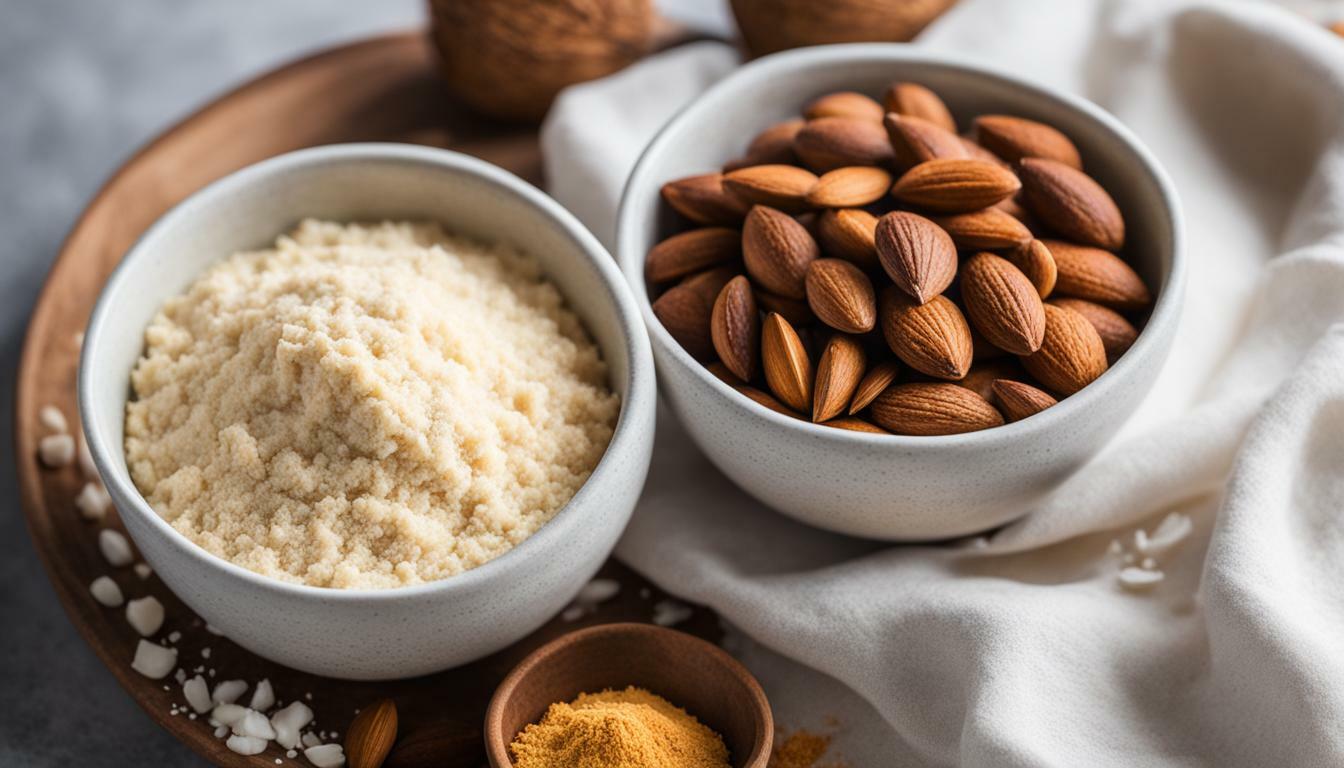Soy sauce and teriyaki sauce are both commonly used in the culinary world, but they have distinct differences in flavor, ingredients, and uses. Understanding these differences can help you elevate your dishes and create unique flavor profiles.
Key Takeaways:
- Soy sauce has a salty flavor, while teriyaki sauce is sweeter and more complex.
- Soy sauce is made from fermented soybeans, while teriyaki sauce includes additional ingredients like brown sugar, ginger, and garlic.
- Both sauces have versatile uses in cooking, but they are not interchangeable in all recipes.
- Soy sauce is commonly used in Asian cuisine, while teriyaki sauce is popular in dishes that require a sweet and savory flavor profile.
- Consider the sodium and sugar content when using these sauces and opt for reduced-sodium or low-sugar options if necessary.
Flavor Differences
Soy sauce and teriyaki sauce have distinct flavor profiles that set them apart in the culinary world. Soy sauce is known for its salty taste, which is commonly associated with Asian cuisine. It is derived from a mixture of water, salt, and fermented soybean paste. The fermentation process gives soy sauce its rich umami flavor.
On the other hand, teriyaki sauce offers a sweeter taste compared to soy sauce. This sweetness comes from additional ingredients like brown sugar, ginger, and garlic. The combination of these ingredients gives teriyaki sauce a complex and flavorful profile that is both sweet and savory.
While both sauces add depth and complexity to dishes, the choice between soy sauce and teriyaki sauce ultimately depends on the desired flavor outcome. Soy sauce provides a salty and umami flavor, while teriyaki sauce offers a sweeter and more complex taste.
| Soy Sauce Flavor | Teriyaki Sauce Flavor |
|---|---|
| Salty | Sweet and savory |
| Umami | Complex and flavorful |
| Associated with Asian cuisine | Offers a unique taste experience |
Ingredient Variations
Soy sauce and teriyaki sauce may have similarities, but their ingredients differ significantly. Let’s take a closer look at the key components that make up these two popular sauces.
The Ingredients of Soy Sauce
Soy sauce is a simple yet flavorful condiment made from fermented soybeans, water, and salt. The fermentation process involves combining soybeans with a grain like wheat or barley, along with the presence of a specific mold known as koji. This mixture is left to ferment for several months, resulting in a dark-colored, umami-rich liquid.
Traditional soy sauce recipes typically contain four essential ingredients: soybeans, wheat, salt, and water. However, there are variations in soy sauce recipes across different regions and brands, which may include additional ingredients like sugar or preservatives.
The Ingredients of Teriyaki Sauce
Teriyaki sauce shares a similar base with soy sauce but incorporates additional ingredients to create its unique flavor profile. In addition to soy sauce, teriyaki sauce typically contains brown sugar, ginger, and garlic. These ingredients contribute to its characteristic sweet and savory taste.
Some variations of teriyaki sauce may also include other ingredients like mirin (a sweet rice wine), rice vinegar, or sesame seed oil. Chefs and home cooks often customize their teriyaki sauce recipe by adding their preferred combination of seasonings.
| Soy Sauce | Teriyaki Sauce |
|---|---|
| Soybeans | Soy sauce base (soy sauce, brown sugar, ginger, garlic) |
| Wheat | Brown sugar |
| Salt | Ginger |
| Water | Garlic |
| – | Mirin (optional) |
| – | Rice vinegar (optional) |
| – | Sesame seed oil (optional) |
As shown in the table above, the ingredients of soy sauce are comparatively simpler, while teriyaki sauce incorporates a wider range of flavors. These differences in ingredients contribute to the distinctive tastes and versatile uses of each sauce in various culinary dishes.
Uses in Cooking
Both soy sauce and teriyaki sauce have versatile uses in cooking. Here are some common ways they are used:
- Dipping Sauce: Soy sauce is often used as a dipping sauce for sushi, dumplings, and other Asian appetizers. Teriyaki sauce can also be used as a dipping sauce, particularly for grilled or broiled meats.
- Marinade: Soy sauce is a popular marinade for meats and vegetables, as it adds a savory, umami flavor. Teriyaki sauce, with its sweet and savory profile, is also commonly used as a marinade, especially for grilled or stir-fried dishes.
- Glaze: Both soy sauce and teriyaki sauce can be used as glazes for meats, seafood, and vegetables. They add flavor and help create a caramelized, glossy finish.
- Stir-Fry Sauce: Teriyaki sauce is a key component in many stir-fry recipes, as it provides a balance of sweetness and tanginess. Soy sauce is also commonly used in stir-fries to add depth of flavor.
- Soup Base: Soy sauce is often added to soups and broths to enhance their flavor. Teriyaki sauce can also be used to add a sweet and savory element to certain soups.
These are just a few examples, but both soy sauce and teriyaki sauce can be used creatively in various dishes to enhance their taste and add depth of flavor.

Quotes:
“Soy sauce is a versatile ingredient that can be used in a variety of dishes to add a savory, umami flavor.” – Chef Jane Doe
“Teriyaki sauce is perfect for adding a sweet and tangy twist to grilled meats and stir-fried dishes.” – Chef John Smith
Price and Availability
When it comes to price and availability, there are some differences between teriyaki sauce and soy sauce. Teriyaki sauce is generally more expensive than soy sauce. This is because teriyaki sauce requires additional ingredients like brown sugar, ginger, and garlic, which can drive up the cost of production.
However, both teriyaki sauce and soy sauce are readily available in stores and restaurants. You can easily find them in the condiment aisle or the Asian food section of your local grocery store. They are also commonly used in various cuisines and can be found in different brands and varieties.
If you’re looking for a specific type of teriyaki sauce or soy sauce, you can also find them online. Many online retailers offer a wide selection of sauces, including low-sodium and low-sugar options. This allows you to choose the sauce that best fits your dietary needs and preferences.
| Teriyaki Sauce | Soy Sauce | |
|---|---|---|
| Cost | Generally more expensive | More affordable |
| Availability | Widely available in stores and online | Widely available in stores and online |
| Options | Various brands and varieties | Various brands and varieties |
So, whether you’re in need of teriyaki sauce or soy sauce, rest assured that you can easily find them at your convenience. Just keep in mind that teriyaki sauce may be a bit pricier due to its additional ingredients, but both sauces offer a wide range of options to suit your taste and dietary preferences.

When it comes to soy sauce and teriyaki sauce, it’s important to understand their differences to make informed choices in your cooking. While these two sauces share some similarities, they have distinct flavors, ingredients, and uses that set them apart. Let’s take a closer look at how soy sauce and teriyaki sauce compare.
Flavor Differences
Soy sauce is known for its salty taste, which is derived from fermented soybeans. It has a rich umami flavor that adds depth to dishes. On the other hand, teriyaki sauce is sweeter due to the addition of ingredients like brown sugar, ginger, and garlic. The sweetness of teriyaki sauce balances well with savory dishes, providing a unique flavor profile.
Ingredient Variations
Soy sauce consists of soybeans, water, and salt, making it a simpler and more traditional sauce. Teriyaki sauce, while also having a soy sauce base, incorporates additional ingredients such as brown sugar, ginger, and garlic. Some chefs may even add sesame seed oil and green onions to elevate the flavor of their teriyaki sauce.
Uses in Cooking
Both soy sauce and teriyaki sauce have versatile uses in cooking, but they are not interchangeable in all recipes. Soy sauce is commonly used for dipping, glazing, and marinating, and it is a staple in many Asian dishes. On the other hand, teriyaki sauce is particularly popular in dishes that require a sweet and savory flavor profile, such as teriyaki chicken or beef. It adds a delicious caramelized glaze to the meat.
| Soy Sauce | Teriyaki Sauce |
|---|---|
| Salter taste | Sweeter taste |
| Simple ingredients: soybeans, water, salt | Additional ingredients: brown sugar, ginger, garlic |
| Used for dipping, glazing, marinating | Popular in teriyaki dishes |
While soy sauce and teriyaki sauce may have some similarities, understanding their distinct differences allows you to choose the right sauce for your culinary needs. Whether you prefer the saltiness of soy sauce or the sweetness of teriyaki sauce, each brings its own unique flavor to dishes and can elevate your cooking to new heights.
Tips and Recommendations
When it comes to using soy sauce and teriyaki sauce in your cooking, there are a few tips and recommendations to keep in mind. These sauces can add depth and flavor to your dishes, but it’s important to use them in the right way for the best results.
Flavor Balance:
Both soy sauce and teriyaki sauce have strong flavors, so it’s crucial to find the right balance when incorporating them into your recipes. Taste test as you go, adding small amounts at a time, and adjust according to your personal preference. Remember that a little goes a long way, especially with soy sauce, so start with a small quantity and gradually increase if needed.
Consider Sodium and Sugar Content:
Soy sauce and teriyaki sauce can be high in sodium and sugar, so if you’re watching your intake, opt for reduced-sodium or low-sugar options. These alternatives can help you maintain a healthier diet without compromising on taste. Be sure to read the labels when purchasing these sauces and choose the ones that align with your dietary needs.
Experiment with Different Recipes:
Don’t be afraid to get creative and experiment with soy sauce and teriyaki sauce in various recipes. While they are commonly used in Asian cuisine, they can also be incorporated into a range of dishes from different cuisines. Add them to stir-fries, marinades, salad dressings, or even as a dipping sauce for grilled meats. The possibilities are endless, so have fun exploring different flavor combinations.
| Soy Sauce | Teriyaki Sauce | |
|---|---|---|
| Flavor | Salty | Sweet and savory |
| Main Ingredients | Fermented soybeans, water, salt | Soy sauce, brown sugar, ginger, garlic |
| Uses | Dipping, glazing, marinating | Dipping, glazing, teriyaki dishes |
| Price | Affordable | More expensive |
Remember, soy sauce and teriyaki sauce offer unique flavors and can enhance your culinary creations. Use them in moderation, be mindful of the sodium and sugar content, and have fun exploring different recipes. With these tips and recommendations in mind, you’ll be able to elevate your dishes and create a memorable dining experience.
Conclusion
In conclusion, soy sauce and teriyaki sauce may both be popular condiments in the culinary world, but they have distinct differences that set them apart. Soy sauce is known for its salty flavor and is made from fermented soybeans, while teriyaki sauce offers a sweeter taste with the addition of ingredients like brown sugar, ginger, and garlic. These sauces have versatile uses in cooking, with soy sauce being a staple in Asian dishes and teriyaki sauce adding a sweet and savory touch to various recipes.
It’s important to note that while these sauces can be used in cooking, they are not always interchangeable. Substituting teriyaki sauce for soy sauce may work in recipes that include ginger, sugar, or honey, but the overall flavor and texture will be different. It’s recommended to taste test and adjust the quantities accordingly to achieve the desired balance.
When using soy sauce and teriyaki sauce, it’s also essential to consider the sodium and sugar content. Opting for reduced-sodium or low-sugar options can be a healthier choice. Both sauces are widely available in stores and restaurants, making it easy to incorporate them into your culinary creations.
By understanding the flavor differences, ingredient variations, and uses of soy sauce and teriyaki sauce, you can elevate your cooking and explore new taste experiences. So, whether you’re preparing a traditional Asian dish or experimenting with fusion cuisine, these sauces can add a delicious touch to your creations.
FAQ
What is the difference between soy sauce and teriyaki sauce?
Soy sauce is made from fermented soybeans and has a salty taste, while teriyaki sauce is sweeter and includes additional ingredients like brown sugar, ginger, and garlic.
How are the flavors of soy sauce and teriyaki sauce different?
Soy sauce has a salty flavor, while teriyaki sauce is sweeter and has a more complex taste profile.
What ingredients are used in soy sauce and teriyaki sauce?
Soy sauce is made from soybeans, water, and salt. Teriyaki sauce includes the base of soy sauce but also incorporates brown sugar, ginger, garlic, and sometimes additional ingredients like sesame seed oil and green onions.
What are the uses of soy sauce and teriyaki sauce in cooking?
Soy sauce is commonly used for dipping, glazing, and marinating, and is a staple in many Asian dishes. Teriyaki sauce is also used for dipping and glazing but is especially popular in dishes that require a sweet and savory flavor profile, such as teriyaki chicken, beef, or salmon.
Are soy sauce and teriyaki sauce interchangeable in recipes?
Teriyaki sauce can be used as a substitution for soy sauce in recipes that include ginger, sugar, or honey, as it has a similar base. However, the taste and texture will vary significantly. It is recommended to use Worcestershire sauce, fish sauce, or tamari as alternatives to soy sauce, depending on the desired outcome.
How much do soy sauce and teriyaki sauce cost and where can they be found?
Teriyaki sauce is generally more expensive than soy sauce due to the additional ingredients involved in its preparation. Both sauces are widely available in stores and restaurants, with reduced-sodium and low-sugar options often being offered.
Are there any tips or recommendations for using soy sauce and teriyaki sauce?
When using these sauces in cooking, it is important to consider the desired flavor profile and adjust the quantities accordingly. Taste testing while adding the sauces is recommended to achieve the desired balance. Additionally, be mindful of the sodium and sugar content, and opt for reduced-sodium or low-sugar options if necessary. Exploring different recipes and experimenting with the sauces can lead to discovering new flavor combinations.
 Skip to main content
Skip to main content


